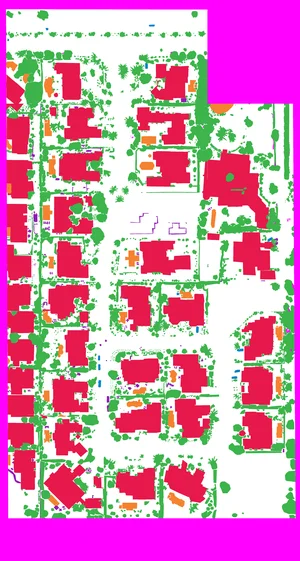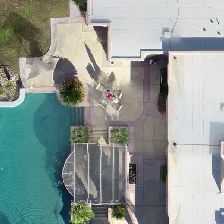
A PyTorch pipeline for semantic segmentation on orthographic drone imagery.


Setup | Configuration | Data | Model | Notes | Citation
Clone this repository.
git clone https://github.com/kelvindecosta/heimdall.git && cd heimdallInstall dependencies.
pip install -r requirements.txtAll configuration settings for the dataset and model are specified in config.yml.
When the pipeline is executed for the first time, this file is generated based on the template specified in templates/conf.yml.
Familiarize yourself with the configuration settings to better understand the pipeline.
The DroneDeploy Segmentation Dataset contains orthographic drone imagery of urban areas.
Each image has a corresponding label. In the labels each pixel has one of 7 colors (RGB) corresponding to the different classes.
Note that unlabelled pixels are magenta in color in the label.
| Image | Label |
|---|---|
 |
 |
In the configuration, dataset.classes is a list of dictionaries each with:
nameindicating the name of the classcolor, a 3-item list denoting the RGB value of the pixels labelled for that class
Two datasets are available for download, one much smaller than the other. In the configuration:
dataset.choiceselects one particular dataset.dataset.urlsis a dictionary of download links for the datasets
Run the following command to download the dataset:
python main.py downloadAn archive begins to download into the downloads/ directory.
Once the download is complete, the dataset is extracted into the data/ directory.
Note that the provided links point to slightly modified versions of the original datasets. The differences are:
- the absence of the elevation images
- the replacement of
index.csvwithindex.json, which specifies the sample set splitting ("train", "valid" and "test")
Each image, along with its corresponding label, must be broken into smaller square tiles. This is done because:
- smaller input sizes speeds up the training process of the model.
- unlabelled pixels can be easily ignored (by ignoring the entire tile, rather than the entire image).
In the configuration, dataset.size denotes the size of the generated square tiles in pixels.
Run the following command to generate tiles from the dataset.
python main.py tileTiles are saved in the tiles/ subdirectory of the downloaded dataset.
| Image Tile | Label Tile |
|---|---|
 |
 |
Note that:
- depending on the size of the image and tile size, border pixels might get lost during tiling.
- tiles that would contain at least one unlabelled pixel are not generated.
Images and labels are augmented based on the dataset.transformations.augmentation configuration.
Note that these augmentations are performed using the
albumentationsPython package.
Images are transformed before feeding directly into the model based on the dataset.transformations.preprocessing configuration.
Note that these transformations are performed using the
torchvision.transformsmodule
The model configuration specifies the:
architectureof the neural network.metricfor accuracy.criterioni.e., the loss function.optimizerwhich handles gradient descent and backpropagation.schedulerwhich changes the learning rate across epochs.batch-sizesfor different phasesepochsi.e., the number of iterations on the entire dataset.
Note that the model definitions in the
segmentation-models-pytorchpackage are used in this pipeline.
Run the following command to train a model:
python main.py trainRun information is stored in the runs/ directory.
Each run is uniquely identified by the time at the start of its execution.
The configuration file is copied for reference.
Models are saved in the corresponding run directory, after the first epoch. If a model performs better on the validation set than it did in the previous epoch, it is overwritten.
The pipeline also provides support for tensorboard logging:
tensorboard --logdir=runsUse the following command template to perform predictions:
python main.py predict <input_path> <model_path> <output_path>The pipeline can be improved by:
- using loss functions that account for class weights.
- allowing a model to resume training after interruption.
If you use this pipeline in your work, please cite the following:
@misc{decosta2020heimdall,
author = {Kelvin DeCosta},
title = {Heimdall},
year = {20202},
howpublished = {\url{https://github.com/kelvindecosta/heimdall}},
}